
|
The Kenko KNT-20 Lens Attachment An inexpensive alternative for the Olympus C-5050Z |

| My other pages related to the Olympus C-5050Z, C-5060WZ, and X-7070WZ |
|
I'm not very enthusiastic about third-party attachment lenses for digital still cameras. Having tried a few in the past I came to expect their performance to range from mediocre to barely so-so, and construction shabby. The exceptions were few and far between. I'm not even talking about fly-by-night eBay "specials" with inventive names like Crystal Clear Optics and some others; some established photo equipment distributors also often sell attachment lenses you should rather stay away from. Quite often these are attachments originally designed for video cameras which need much lower resolution than still ones; such an attachment may provide image quality more than sufficient for video and most disappointing for still photography. In particular, I had some bad experience with Kenko add-on lenses on the C-3000Z (and I've seen some very bad samples submitted by the Readers, too). This is why I was ready to dismiss Kenko as a low-quality brand (in spite of the company going back forty years or so; I remember them making teleconverters for Exakta!). And then a fellow photographer and '5050 user, Charles Stanley, emailed me a number of pictures shot with that camera and an inexpensive Kenko KNT-20 attachment lens: Look, seems like I found something! Charles has been using the KNT-20 for more than a year, and the results are at least respectable and often impressive; combined with the low price and rather small size of the lens, this may create a nice alternative for the C-5050Z users who would like to extend the long end of their zoom reach. This article shows a few examples of images shot with the KNT-20, and some remarks based on scrutiny of a larger number of such samples. Basic data on the lens are also provided. The specs
| |
|
The manufacturer's (or rather U.S. distributor's) product page for the KNT-20 is some kind of a joke: in addition to picture, all specifications are shown as zeros — somebody just forgot to finish the page, and nobody has ever noticed that. (I won't even mention the creative spelling in their graphic links; this would be nitpicking.) Too bad, as the THK web site is generally OK, certainly better than that of the Olympus USA. |
.jpg) (Picture by THK Photo Products) |
Here are the basic specs of the KNT-20, compiled, if not obvious from handling the lens, from other available sources.
| |
|
Mounting on the camera The 52 mm rear thread means that, in addition to one of the lens adapters required for the '5050, you may need a proper step-up ring: either 43->52 mm or 49->52 mm, depending on the adapter you're using (Kenko's own adapters have, if I remember right, a 52 mm front thread, so they would require no step-up ring at all). Charles uses the Raynox 5241 adapter tube with this lens. The lens itself has a 67 mm front thread, which is a good news (Olympus TCON-17 does not have one). Samples As usual in my sample pages, images on the left are full frames, reduced and re-sharpened. Those on the right are full pixel-size samples (one pixel on screen equals one pixel in camera's output files), just cropped to a small fragment and saved at low JPEG compression without any manipulation. Note that the 1:1 samples viewed on an 90 DPI monitor screen are much larger than they would be on a print: for 8x10" prints, the sample height will correspond to 1.14" (29 mm) on paper, while for 11x14" ones — to 1.57" (40 mm). The top shot was taken without the attachment, to provide a comparison of viewing angle and image sharpness against the second one, shot with the KNT-20. Both used identical camera settings; in particular, the lens was almost wide open — the used aperture of F/3.2 is close to the maximum one (F/2.6) at the longest focal length. | |
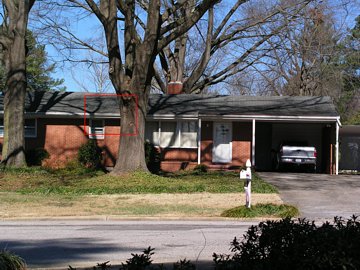
|
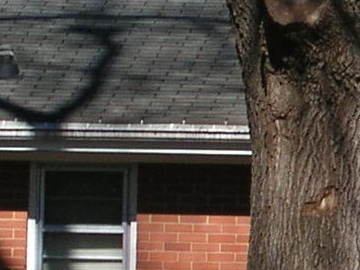
| |
|
Without KNT-20: aperture priority, 1/800 s at F/3.2, ISO 64; zoom at 21.3 mm (EFL=105 mm).
Other settings: sharpness at 0, contrast at -5, saturation at +2, auto WB. (Yes, these are settings Charles prefers in most of his work with the '5050, and he's getting some very nice results!). | ||
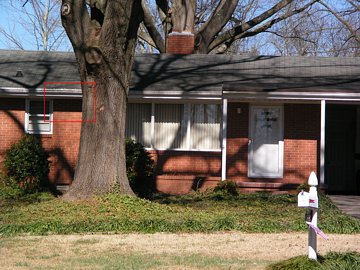
|
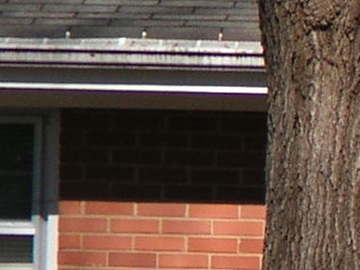
| |
|
With KNT-20: aperture priority, 1/800 s at F/3.2, ISO 64; F=42.6 mm (EFL=210 mm) All other settings as above.
The original, unaltered image can be found here (1MB). | ||
|
This example was enough to convince me to the KNT-20; a close scrutiny of others just confirmed this impression. The lens may be inexpensive, but its performance is far from cheap, hard to tell apart from the Olympus' own TCON-17. Interestingly, the attachment-plus-lens combination works fine even at widest apertures; stepping down to F/8 does not introduce a visible improvement (although the depth of field will be greater, of course). The next sample was intended to check for the lens chromatic aberration (together with sensor's purple fringing; both effects are difficult to separate from each other). It is just one of the series, which was shot at various angles with respect to the sunlight and at various weather conditions. | ||
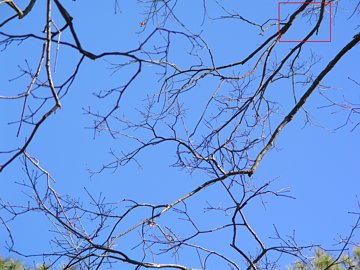
|
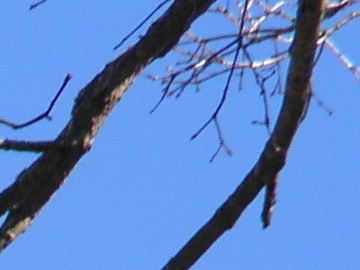
| |
| With KNT-20: aperture priority, 1/500 s at F/2.6, ISO 64. All other settings as above. | ||
|
I cannot see any problems here, nor in any other samples I had available. (To be honest, the color aberration is much harder to avoid in wide-angle lenses, so no big deal. Still, nice to know.) Update: more samples If this is not enough, here are two more samples, shot handheld with another KNT-20 by Frank Carbone at the 2005 AC Delco Canadian Nationals. | ||
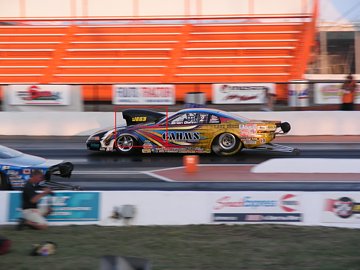
|
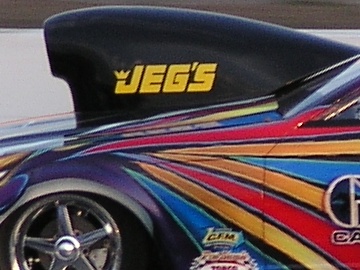
| |
|
With KNT-20: program exposure, 1/200 s at F/3.1, ISO 64, zoomed out (EFL=210 mm). Default contrast, saturation and sharpnes, auto WB, sequential drive mode.
A cropped and (slightly) tonally adjusted XGA version can be found here. | ||
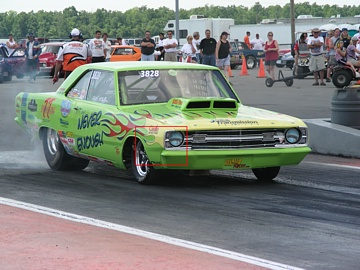
|
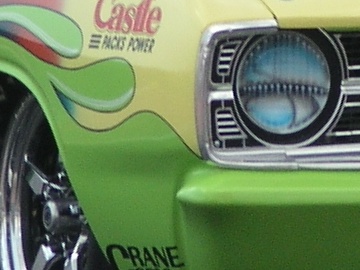
| |
| With KNT-20: program exposure, 1/400 s at F/4, ISO 64, auto WB, single drive mode; other settings as above. | ||
|
Solid lens performance, I would say, especially with aperture close to wide open. The first image, with panning done just right, is pure eye candy. Once again, once the lens is "good enough", it is the photographer who takes the picture. Certainly, in this kind of shooting it is not the lens which will be your bottleneck. (And, if you ask, the front wheels in the first picture seem, indeed, to be locked.) Conclusions and recommendations Contrary to our expectations, the KNT-20 turned out to be a solid performer when matched with the built-in zoom of the C-5050Z. There is no objectionable loss of sharpness, no visible chromatic aberration, and no vignetting to be seen. Even if you zoom out down to F=18mm (EFL=90mm) or so, the combination still works just fine. This is true even with the aperture wide open. | ||

|
My subjective feeling is that the TCON-17 may have a slight edge in optical quality, visible under a close scrutiny of full-size samples. The diference is, however, insignificant for most practical purposes. Yu can get some real eye candy out of the KNT-20, as this sample shows.
Picture at left: photographer's daughter-in-law, shot with the KNT-20 in available light from 20-25 feet distance. Shutter priority, 1/160s at F/2.6, ISO 100. No postprocessing except reduction and re-sharpening.
| |
|
The three-element construction has proven to be adequate for purposes intended (too many elements may cause a trade-off in lens glare and loss of contrast). The attachment is smaller and lighter than the Olympus' own TCON-17 (the latter I found very much to my liking): 32 mm shorter, 9 mm narrower, and 90 g lighter, quite a difference. In addition, it provides the longest EFL of 210 mm, compared to that of about 180 mm with the TCON-17, a noticeable, if not critical, difference. At current prices (May, 2005), the KNT-20 sells at $70 or so (compared to $93 for the TCON-17; this one went down after the camera was replaced with the '5060). If you need a longer focal length for your C-5050Z, this attachment deserves a consideration. KNT-20 on other cameras While I can recommend the KNT-20 attachment for the C-5050Z, things may look differently for other digital cameras. Even with the '5060 the lens-attachment combination may perform not as good. Again, Stanley checked how the KNT-20 works with the Panasonic FZ-15 camera (whose zoom goes all the way to 420 mm EFL), and he says the performance is very, very bad, to say the least. At the same time, he was able to confirm that the Olympus TCON-17 works just fine on the FZ-15, so that, to quote his words, "now I have a stabilized 714mm". I have also seen some negative experiences with the KNT-20 reported on user groups. While some can be easily dismissed (images out of focus, visible camera shake), some cannot. Consider my recommendation above valid only for the C-5050Z. | ||

| My other pages related to the Olympus C-5050Z, C-5060WZ, and X-7070WZ |
| Home: wrotniak.net | Search this site | Change font size |
| Posted 2005/05/10, updated 2005/08/07 |
Copyright © 2005 by J. Andrzej Wrotniak Photos ©2005 by Charles Stanley and Frank Carbone |